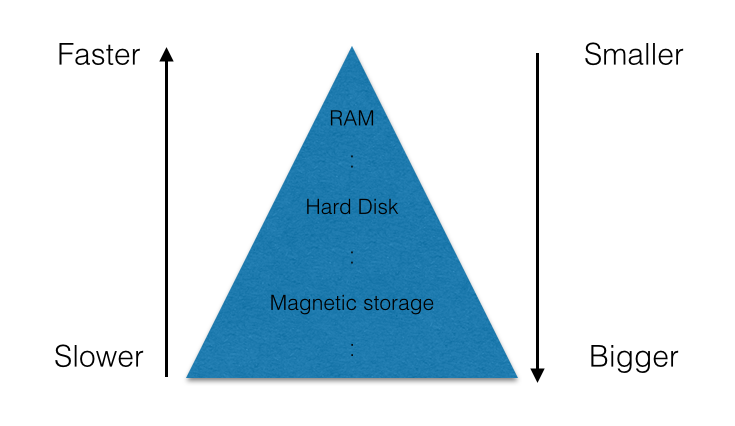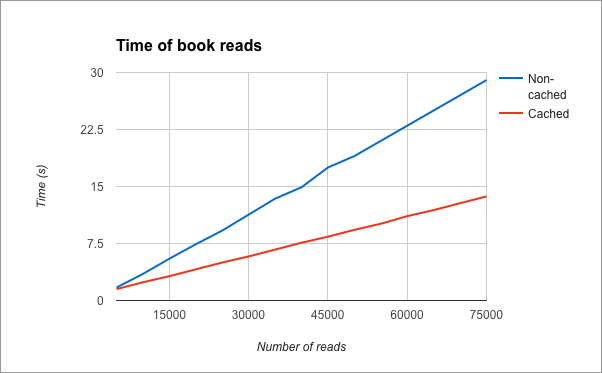Today, performance is one of the most important metrics you need to evaluate when developing a web service. Keeping customers engaged is critical to any company, especially startups, and for this reason it is extremely important to improve the performances and reduce page load times. When running a web server that interacts with a database, its operations may become a bottleneck. MongoDB is no exception here, and as your MongoDB database scales up, things can really slow down. This issue can even get worse if the database server is detached from the web server. In such systems, the communication with the database can cause a big overhead. Luckily, you can use a method called caching to speed things up. In this tutorial we’ll introduce this method and see how you can use it to enhance the performance of your Node.js web service.
Background
Caching is a strategy aimed at tackling the main storage problem, which means: the bigger the storage is, the slower will be, and vice versa. In a computer, you have the hard drive which is big but also relatively slow. You then have the RAM which is faster but smaller in its storage capabilities, and lastly the CPU registers which are very fast but tiny. The following chart showcases the memory problem: A cache is a component that stores recently accessed data in a faster storage system. Each time a request for that data is made, it can (with some probability) be pulled from the faster memory. The underlying assumption behind caching is that data which have been recently read, have a higher chance of being read again. Thus they should be stored in a faster memory so that even the next read will be quicker.
To gain a better understanding of this concept, think about a group of people sitting in a library. The library itself represents a huge storage system, but it’s hard to find some books there. In our imagination, the library is a big and slow storage mechanism. Suppose that these people, whenever they find a book, read it but don’t return it since they rather prefer to keep it on their desks. They have this behavior because they are sure they’ll need it again soon, and it makes sense to keep that book on the table where it is more accessible. In this example, the library is the main storage system, while the table is our cache.
In this tutorial, we’ll build a web service that we’ll call “fastLibrary”. Here we’ll implement the concept of caching for a virtual library. MongoDB will be the main storage system, and we’ll build the cache using Redis. Our web server will work with Express.js. If you are unfamiliar with any of these technologies, I recommend you to deepen these topics before starting the tutorial. For our purpose, I suggest you to give a reading to these articles published on SitePoint:
You can find all the code for this tutorial in this GitHub repository.
A cache is a component that stores recently accessed data in a faster storage system. Each time a request for that data is made, it can (with some probability) be pulled from the faster memory. The underlying assumption behind caching is that data which have been recently read, have a higher chance of being read again. Thus they should be stored in a faster memory so that even the next read will be quicker.
To gain a better understanding of this concept, think about a group of people sitting in a library. The library itself represents a huge storage system, but it’s hard to find some books there. In our imagination, the library is a big and slow storage mechanism. Suppose that these people, whenever they find a book, read it but don’t return it since they rather prefer to keep it on their desks. They have this behavior because they are sure they’ll need it again soon, and it makes sense to keep that book on the table where it is more accessible. In this example, the library is the main storage system, while the table is our cache.
In this tutorial, we’ll build a web service that we’ll call “fastLibrary”. Here we’ll implement the concept of caching for a virtual library. MongoDB will be the main storage system, and we’ll build the cache using Redis. Our web server will work with Express.js. If you are unfamiliar with any of these technologies, I recommend you to deepen these topics before starting the tutorial. For our purpose, I suggest you to give a reading to these articles published on SitePoint:
You can find all the code for this tutorial in this GitHub repository.
The Basic System
As first step, we’ll build a basic web server that stores data in MongoDB. For this demonstration, we’ll name it “fastLibrary”. The server will have two basic operations:- POST
/book: This endpoint will receive the title, the author, and the content of the book, and create a book entry in the database. - GET
/book/:title: This endpoint will get a title and return its content. We assume that titles uniquely identify books (thus, there won’t be two books with the same title). A better alternative would be, of course, to use an ID. However, to keep things simple, we’ll simply use the title.
mkdir fastLibrary
cd fastLibrarynpm initnpm install express --save
npm install mongodb --saveindex.js. It’s the file where we’ll do most of our work. Start off by creating a simple app, connecting it to MongoDB and listening on port 8000:
var express = require('express'),
MongoClient = require('mongodb').MongoClient,
app = express(),
mongoUrl = 'mongodb://localhost:27017/textmonkey';
MongoClient.connect(mongoUrl, function (err, db) {
if (err) throw 'Error connecting to database - ' + err;
app.listen(8000, function () {
console.log('Listening on port 8000');
});
});mongod --dbpath=/data --port 27017access.js:
module.exports.saveBook = function (db, title, author, text, callback) {
db.collection('text').save({
title: title,
author: author,
text: text
}, callback);
};findText function:
module.exports.findBookByTitle = function (db, title, callback) {
db.collection('text').findOne({
title: title
}, function (err, doc) {
if (err || !doc) callback(null);
else callback(doc.text);
});
};var express = require('express'),
MongoClient = require('mongodb').MongoClient,
app = express(),
mongoUrl = 'mongodb://localhost:27017/textmonkey';
var access = require('./access.js');
MongoClient.connect(mongoUrl, function (err, db) {
if (err) throw 'Error connecting to database - ' + err;
app.post('/book', function (req, res) {
if (!req.body.title || !req.body.author) res.status(400).send("Please send a title and an author for the book");
else if (!req.body.text) res.status(400).send("Please send some text for the book");
else {
access.saveBook(db, req.body.title, req.body.author, req.body.text, function (err) {
if (err) res.status(500).send("Server error");
else res.status(201).send("Saved");
});
}
});
app.get('/book/:title', function (req, res) {
if (!req.param('title')) res.status(400).send("Please send a proper title");
else {
access.findBookByTitle(db, req.param('title'), function (book) {
if (!text) res.status(500).send("Server error");
else res.status(200).send(book);
});
}
});
app.listen(8000, function () {
console.log('Listening on port 8000');
});
});Adding the Cache
So far we’ve created a basic library web service, but it’s not astonishingly fast at all. In this section, we’ll try to optimize thefindBookByTitle() function by caching the results.
To get a better idea of how we’ll achieve this goal, let’s go back to the our example of the people sitting in a traditional library. Let’s say they want to find the book with a certain title. First of all, they’ll look around the table to see if they already brought it there. If they have, that’s great! They just had a cache hit, that is finding an item in the cache. If they haven’t found it, they had a cache miss , meaning they didn’t find the item in the cache. In the case of a missing item, they’ll have to look for the book in the library. When they find it, they’ll keep it on their table or insert it into the cache.
In our tutorial, we’ll follow exactly the same algorithm for the findBookByTitle() function. When asked for a book with a certain title, we’ll look for it in the cache. If not found, we’ll look for it in the main storage, that is our MongoDB database.
No changes are going to take place in the saveBook() function as it has no effect over the cache. We need to change the findBookByTitle(), which will have the following flow:
 First of all, we must install the Node.js Redis client. This can be done via npm:
First of all, we must install the Node.js Redis client. This can be done via npm:
npm install redis --saveredis-serverindex.js file, require and initialize the Redis client:
var redisClient = require('redis').createClient;
var redis = redisClient(6379, 'localhost');access.findBookByTitleCached() which will be an enhanced version of what we’ve built earlier. The function will follow the exact logic we just introduced. We’ll store each book’s data in the Redis database, and as we’re querying books by their titles, we’ll use each book’s title as the key to its data.
module.exports.findBookByTitleCached = function (db, redis, title, callback) {
redis.get(title, function (err, reply) {
if (err) callback(null);
else if (reply) //Book exists in cache
callback(JSON.parse(reply));
else {
//Book doesn't exist in cache - we need to query the main database
db.collection('text').findOne({
title: title
}, function (err, doc) {
if (err || !doc) callback(null);
else {\\Book found in database, save to cache and
return to client
redis.set(title, JSON.stringify(doc), function () {
callback(doc);
});
}
});
}
});
};app.get('/book/:title', function (req, res) {
if (!req.param('title')) res.status(400).send("Please send a proper title");
else {
access.findBookByTitleCached(db, redis, req.param('title'), function (book) {
if (!text) res.status(500).send("Server error");
else res.status(200).send(book);
});
}
});Caching Policy
We’ve created a basic system that works with Redis to cache all the query results from the database. However, we must admit that it’s not a smart system. It just saves each result to the Redis cache and keeps it there. In this way, the cache will slowly overload the computer’s RAM until it fills up. Due to this memory limitation, we must delete some of the items in the cache and only keep few of them. Ideally, we would want to keep those with the highest chances of getting read again only. To select the items we want to delete, we have to establish a sort of caching policy. Deleting random items would probably be a valid policy, but it obviously won’t be very effective. We’ll use one of the most popular policies: the LRU (Least Recently Used). This policy deletes the cache items that were (as the name implies) the least recently used. Luckily for us, Redis has an LRU mechanism implemented within it, so we don’t have to bother with it on the application layer. To that end, all we have to do is to configure Redis to delete items on an LRU manner. To achieve that, we’ll add two arguments to the command starting Redis. The first will limit the amount of memory it can use (in this example we chose 512 MB), while the second will tell it to use the LRU policy. The command will look like that:redis-server --maxmemory 10mb --maxmemory-policy allkeys-lruKeeping the Cache Updated
One of the issues that caching introduces is that of keeping the cache up-to-date when data changes. For example, let’s create the endpointPUT /book/:title that enables us to update the text of a certain book. For that, we shall implement the function access.updateBookByTitle(title).
The natural thing to do would be to simply update the record in the main database containing that book. But what if the item is in the cache? In that case, the next time we read it, we’ll get a cache hit and read the item from the cache. But that item would be the not updated version of the book, which means that a user might not get the its latest version. Not all the systems can tolerate this inaccuracy. Thus, we’ll update the cache with the new, updated data.
In that case the implementation of the update function will be the following:
module.exports.access.updateBookByTitle = function (db, redis, title, newText, callback) {
db.collection("text").findAndModify({
title: title
}, {
$set: {
text: text
}
}, function (err, doc) { //Update the main database
if (err) callback(err);
else if (!doc) callback('Missing book');
else {
//Save new book version to cache
redis.set(title, JSON.stringify(doc), function (err) {
if (err) callback(err);
else callback(null);
});
}
});
};app.put('/book/:title', function (req, res) {
if (!req.param("title")) res.status(400).send("Please send the book title");
else if (!req.param("text")) res.status(400).send("Please send the new text");
else {
access.updateBookByTitle(db, redis, req.param("title"), req.param("text"), function (err) {
if (err == "Missing book") res.status(404).send("Book not found");
else if (err) res.status(500).send("Server error");
else res.status(200).send("Updated");
});
}
});Metrics
Now that we have a nice working cached app, it’s time to enjoy the fruit of our work and test the performances of our application. For this test, we have first inserted 1.000 books into the library, and then read them randomly. Now we’ll measure how fast the server response times are in the cached application versus the non-cached one. At the end of the test, these are the results. I put them in a graph:
Conclusions
In this tutorial I have shown how to speed up a web server connected to a database by caching the data it accesses to. Although this tutorial uses Redis as the cache, you can use other key-value stores for the purpose. An example of another popular database is Memcached. I chose Redis mainly because of its popularity, its detailed documentation, and ease of use. While caching is a great performance booster, it isn’t a good fit for every application. Here are some considerations you can think about when thinking about caching:- Do database reads really have a big impact on your performances? You should make some tests and see if that is your real problem
- Are you using many different keys for querying? In the main database, many parameters can be used to query a collection. In the cache, just one key (either one parameter or a collection of parameters) can be used for querying. Caching all the possible keys would probably be harmful. Try to think which queries are used the most and should be cached, instead.
- Does your app perform a lot of database updates? While caching speeds up reads, it also slows down writes.
- Are you trying to cache complex queries? Complex queries will be harder and less efficient to cache.
Premature optimization is the source of all evil.This should remind you that optimizations have their proper time and place. I hope you enjoyed this tutorial and I’ll look forward to reading your thoughts and comments.
Frequently Asked Questions (FAQs) on Caching a MongoDB Database with Redis
What are the key differences between MongoDB and Redis when it comes to caching?
MongoDB and Redis are both powerful databases, but they have different strengths when it comes to caching. MongoDB is a document-oriented database that stores data in a semi-structured format. It is highly scalable and offers powerful querying capabilities. On the other hand, Redis is an in-memory data structure store that is used as a database, cache, and message broker. It is known for its speed and efficiency. Redis is often used as a caching layer for MongoDB to speed up read operations.
How does caching with Redis improve MongoDB performance?
Caching with Redis can significantly improve MongoDB performance by reducing the time it takes to retrieve data. When a query is made, the system first checks the Redis cache. If the data is found there (a cache hit), it is returned immediately, which is much faster than retrieving it from MongoDB. If the data is not in the cache (a cache miss), it is retrieved from MongoDB and also added to the Redis cache for future queries. This process can significantly speed up read operations, especially for frequently accessed data.
How can I set up a Redis cache for my MongoDB database?
Setting up a Redis cache for your MongoDB database involves several steps. First, you need to install and configure Redis on your server. Then, you need to modify your application code to check the Redis cache before querying MongoDB. This usually involves creating a function that takes a query as input, checks if the result is in the Redis cache, and if not, queries MongoDB and stores the result in the cache.
What are the potential drawbacks of caching a MongoDB database with Redis?
While caching with Redis can significantly improve performance, there are potential drawbacks. One is that it adds complexity to your system, as you now have two databases to manage instead of one. Another is that it can increase memory usage, as data is stored in both MongoDB and Redis. Also, there is a risk of data inconsistency if data is updated in MongoDB but not in the Redis cache.
How can I handle data inconsistency between MongoDB and Redis?
Data inconsistency between MongoDB and Redis can be handled by implementing a cache invalidation strategy. This involves updating or removing the corresponding data in the Redis cache whenever data is updated in MongoDB. This ensures that the data in the cache is always up-to-date with the data in MongoDB.
Can Redis be used as a primary database instead of MongoDB?
While Redis can technically be used as a primary database, it is typically used as a cache or message broker due to its in-memory nature. Redis stores data in memory for fast access, but this means that it can be more expensive to store large amounts of data compared to disk-based databases like MongoDB. Also, while Redis does support data persistence, it is not as robust as MongoDB’s data durability and consistency features.
How can I monitor the performance of my Redis cache?
Redis provides several tools for monitoring performance, including the INFO command, which provides information about the Redis server, and the MONITOR command, which shows all commands processed by the Redis server. There are also third-party tools like Redis Monitor and Redis-Stat that provide more detailed performance metrics.
What are some best practices for caching with Redis?
Some best practices for caching with Redis include setting an appropriate TTL (Time To Live) for your cache data to prevent it from becoming stale, using consistent hashing for cache keys to ensure even distribution of data, and implementing a cache eviction policy to manage memory usage.
How does write-behind caching work with MongoDB and Redis?
Write-behind caching is a strategy where data is first written to the cache (Redis) and then written to the database (MongoDB) in the background. This can improve write performance by returning success to the client as soon as the data is written to the cache, without waiting for it to be written to the database. However, this strategy can increase the risk of data loss if the system crashes before the data is written to the database.
Can I use Redis with MongoDB in a microservices architecture?
Yes, Redis can be used with MongoDB in a microservices architecture. Each microservice can have its own MongoDB database for persistent storage and a Redis cache for fast data access. This can provide the benefits of both databases while isolating the data for each microservice.
 Iddo Gino
Iddo GinoI'm a developer and an entrepreneur with more than 4 years of experience at both my own companies and as an employee. I mostly developer for the backend, mainly focusing on structuring and optimizing data storage and applications for scaling. I have worked with both SQL and No-SQL databases and many application platforms. I have started developing when I was 11, and have since worked to bring more teenagers to the entrepreneurial and development world.


